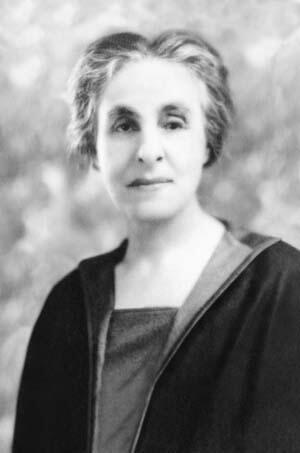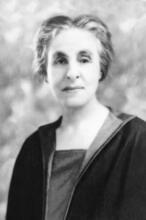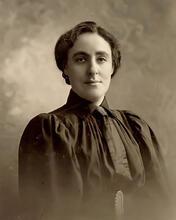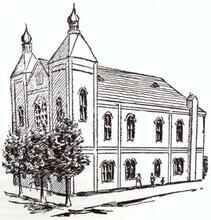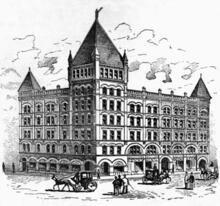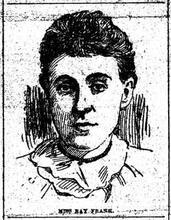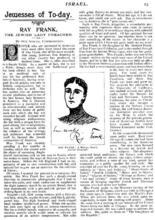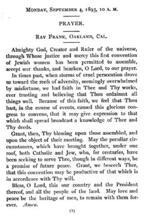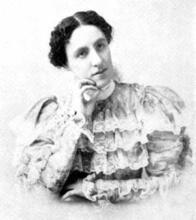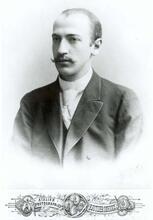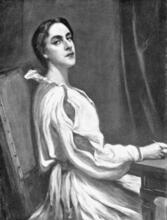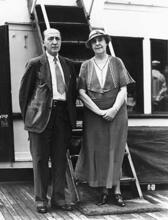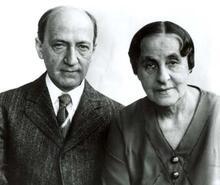Ray Frank
"My position this evening is a novel one.... To be at any time asked to give counsel to my people would be a mark of esteem; but on this night of nights, on Yom Kippur eve, to be requested to talk to you, to advise you, to think that perhaps I am to-night the one Jewish woman in the world, mayhap the first since the time of the prophets to be called on to speak to such an audience as I now see before me, is indeed a great honor..."
Ray Frank's position in American Jewry was truly a novel one. In 1890, she became the first Jewish woman to preach formally from a pulpit in the United States, inaugurating a career as "the Girl Rabbi of the Golden West" that would help to blaze new paths for women in Judaism. Virtually overnight, Frank became a sensation in the Jewish world, and she would remain so for nearly a decade.
Coinciding with a broader emergence of public roles for Jewish women, Frank's career reinvigorated and redirected an ongoing conversation about the proper boundaries of the female sphere. Earlier in the nineteenth century, women like Rebecca Gratz had explored new responsibilities in many area, including education and philanthropy. But the expansion of American Jewish women's social and cultural opportunities had not been matched by expansion of their religious roles. Although women had become the majority at many congregations' services, their participation in public ritual was still limited to the occasional mixed-sex choir.
Despite the fact that Frank claimed to have no interest in becoming a rabbi, her actions forced American Jewry to consider the possibility of the ordination of women seriously for the first time. Frank spoke passionately about the abilities and spirituality of Jewish women and had no doubt about the necessity of their becoming a greater presence in the synagogue. The content of her speeches and her presence as a female religious leader not only served as an inspiration to the women who heard her, but also demonstrated to the Jewish world that Jewish women were ready for widespread change.
Notes:
- Opening quotation from "A Lay Sermon by a Young Lady," The American Hebrew, October 1, 1890, 183.
Early Influences
Born in San Francisco on April 10, 1861, Rachel ("Ray") Frank was the daughter of Polish immigrants, Bernard and Leah Frank, whom Ray later described as "Orthodox Jews of liberal mind." Her father, a peddler and Indian agent, claimed descent from the eighteenth-century Jewish sage, the Vilna Gaon.
Soon after her graduation from Sacramento High School in 1879, Frank moved to the silver-mining town of Ruby Hill, Nevada, where she taught public school. Although nearby Eureka, where Frank's sister Rosa lived, had over 100 Jewish inhabitants and the first synagogue in Nevada, Ruby Hill was home to few Jews, as were the western territories overall.
The contrast between the non-Jewish surrounding environment and the Jewish household in which she was raised provided rich food for Frank's fertile mind. She later wrote, "Although reared among non-Jews, my childhood's home being in the heart of the Sierra Nevada Mts and later on in the state of Nevada, I at an early age became much interested in all that concerned the Jews. Living where prejudices of a theological kind were unknown, one of the prime factors of this early interest was the desire to understand the cause and meaning of prejudice against the Jew." In the 1890s, Frank would examine these ideas in her sermons, lectures, and newspaper articles.
Frank's time in Nevada set the stage for her subsequent career in other ways as well. Six years as a teacher gave her a self-assurance and confidence as a public speaker that would impress subsequent observers. She also published her first article, about education, in the Daily Elko Independent.
Learn more about Jews of the West.
Notes:
- Quote from draft of letter from Ray Frank to Reverend S.T. Willis, December 15, 1896, Box 1, Letters from R.F. Litman and to Stetson and to S.T. Willis, Ray Frank Litman Collection, American Jewish Historical Society.
- The main source of information about Frank's life is the memoir by her husband, Simon Litman, Ray Frank Litman: A Memoir(New York: American Jewish Historical Society, 1957). See also Pamela S. Nadell, Women Who Would Be Rabbis: A History of Women's Ordination 1889-1985 (Boston: Beacon Press, 1998).
- For information on Nevada Jewry, see Norton B. Stern, "The Jewish Community of a Nevada Mining Town," Western States Jewish Historical Quarterly, 15, no. 1 (1982): 48-78.
Establishing a Reputation
In 1885, with the mining industry in decline, Frank left Nevada and returned to her family in Oakland, California. While supporting herself by giving lessons in literature and elocution, she broadened her own education by enrolling in courses in philosophy at the University of California-Berkeley. She also began working in the Sabbath School of Oakland's First Hebrew Congregation, transferring her already established teaching skills to a Jewish setting.
Frank proved extremely popular as a religious-school teacher. She soon attracted a wide following of adults as well as children to her classes, to such an extent that when the rabbi and school superintendent resigned, the congregation invited her to become principal. Involvement with the Sabbath school not only gave Frank the opportunity to explore the Jewish issues that had long interested her, but it also allowed her to hone her skills as a public speaker and to begin to make a name for herself within the California Jewish community.
Frank's work as a correspondent for several San Francisco and Oakland newspapers added to her growing reputation. She also began to use letters to the editors of national Jewish publications to express her ideas about the state of American Jewry, increasing her visibility in Jewish circles. When the Jewish Messenger asked its readers "What would you do if you were a rabbi?," Frank submitted a letter expounding emphatically on what she would not do if she were a rabbi. Castigating Jewish leadership for its shallowness, insincerity, and materialism, she argued that amid the freedom and prosperity of the New World, many Jews had lost sight of the spiritual and moral bases of Judaism. She deplored the acrimony between Reform and Orthodox Jews and even broached the question of women and religious leadership, concluding with the observation that "Women are precluded from entering the Holy of Holies; but it is a great satisfaction to contemplate what we would not do were the high office not denied us."
Notes:
- Quote from Ray Frank, "A Jewess on the Rabbi Question," reprinted in Jacob R. Marcus, The American Jewish Woman: A Documentary History (NY: Ktav Publishing House, Inc., 1981), 383.
- Information about Frank's life is from Simon Litman, Ray Frank Litman: A Memoir (New York: American Jewish Historical Society, 1957).
The Maiden in the Temple
In the fall of 1890, Frank's newspaper work took her to the Northwest to visit a number of the region's booming new towns. During this tour, an event occurred that transformed Frank into the Jewish community's first "lady preacher."
Arriving in Spokane, Washington (then known as Spokane Falls), on the eve of the High Holy Days, Frank was shocked to find that, despite the presence of many affluent Jews, the town had no synagogue. Apparently the community's Orthodox and Reform elements were so divided that they were unwilling to join together for services. When Frank expressed her dismay, a prominent member of the community—knowing her by reputation—offered to arrange for Rosh Hashanah services if she would give a sermon. Frank readily agreed.
At five o'clock that afternoon, a special edition of the Spokane Falls Gazette announced that "a young lady" would preach to Spokane's Jews that evening at the Opera House. Intrigued, the townspeople—Christians as well as Jews—flocked to the theater. Frank did not herself conduct the service; a woman preaching from the pulpit on the High Holidays was extraordinary enough in the late nineteenth century. But the impassioned sermon she delivered after the service made a deep impression on the audience. Speaking on "The Obligations of a Jew as Jew and Citizen," she entreated her listeners—for their own sake and that of their children—to overcome the differences between Reform and Orthodox ritual and to form a permanent congregation. A Christian man in the audience was so deeply inspired by Frank's words that, at the conclusion of the service, he offered to donate land for the construction of a synagogue.
Frank so impressed Spokane's Jews that they invited her to remain throughout the High Holidays. In the sermon she delivered on the eve of Yom Kippur, she elaborated on her earlier theme. "Drop all dissension about whether you should take off your hats during the service and other unimportant ceremonials," she implored her listeners, "and join hands in one glorious cause."
Notes:
- Heading is from "The Maiden in the Temple," San Francisco Examiner, November 13, 1892.
- The phrase "lady preacher" is from "Jewesses of To-Day: Ray Fran, the Jewish Lady Preacher," Israel: The Jewish Magazine, April 1899: 23.
- Quote beginning "Drop all dissension..." is from "A Lay Sermon by a Young Lady," The American Hebrew, October 1890, 183.
- The story of Frank's first sermon can be found in several places. See especially Simon Litman, Ray Frank Litman: A Memoir (New York: American Jewish Historical Society, 1957); Reva Clar and William M. Kramer, "The Girl Rabbi of the Golden West: The Adventurous Life of Ray Frank in Nevada, California and the Northwest," Part I, Western States Jewish History, 28, no. 2 (1986): 99-111; and "Jewesses of To-Day: Ray Fran, the Jewish Lady Preacher," Israel: The Jewish Magazine, April 1899: 23.
Breaking Down Barriers
Soon, the American Jewish world was abuzz with the news that a woman—a "latter-day Deborah"—had transcended the traditional boundaries of the female sphere and stepped up to the pulpit. Traditional Judaism had allocated few public religious roles to women, who did not count towards the minyan (quorum) of ten required for public worship, could not read from the Torah, and, if they attended synagogue, were seated separately from men. Religious leadership lay strictly in the hands of men, whose voices dominated the synagogue.
By the 1890s, American Jews had begun to make some changes to this traditional order. The widespread introduction of family pews in acculturated congregations had redefined women's presence in the synagogue, mixed-sex choirs had brought women's voices in to the service, and a new confirmation service for girls as well as boys had acknowledged the importance of female religiosity. Moreover, as Jewish men became increasingly absorbed in the bustle of everyday life, women began to outnumber men at many congregation's services. But despite these advances, Frank still defied longstanding norms when she assumed the right to speak and teach within the synagogue context. "I know that it is unusual, and that in the history of our people no woman except Deborah spoke in the synagogue, yet the experience did not seem strange," she commented.
The newness of the Jewish communities in the West likely contributed significantly to Frank's ability to do what she did. Had more established Jewish institutions and a well-entrenched Jewish leadership existed on the West Coast, Frank might never have been given the opportunity to preach. By occupying the pulpit temporarily, Frank opened the door, however slightly, for Jewish women's long journey towards public religious leadership.
Notes:
- Quote is from "The Maiden in the Temple," San Francisco Examiner, November 13, 1892.
- Information about changes in women's place in the synagogue can be found in Karla Goldman, Beyond the Synagogue Gallery: Finding a Place for Women in American Judaism (Cambridge, MA: Harvard University Press, 2000).
Career of a Lady Preacher
The 1890s were a whirlwind for Frank, who became "the most talked of Jewess of to-day." Dubbed "the Maiden in the Temple" by the Spokane paper and "the Jewess in the Pulpit" by the Cincinnati Israelite, Frank was soon launched into a new career. As articles about her groundbreaking preaching appeared in both Jewish and non-Jewish publications across the country, more and more communities wished to hear for themselves the newest sensation in American Jewry.
Up and down the Pacific coast, Frank traveled from her home in the bay area of California to Los Angeles, San Diego, and Stockton, Nevada, Oregon, and British Columbia, addressing enthusiastic audiences along the way. In addition to giving lectures to B'nai B'rith lodges, literary societies, and synagogue women's groups, she spoke in both Reform and Orthodox synagogues, giving sermons, officiating at services, or, as at San Francisco's Temple Emanuel in 1895, reading Scripture. Unfortunately, because contemporary reports do not indicate exactly what her "officiating" entailed, the extent to which Frank ever took on the strictly religious functions of a rabbi remains unclear.
Many of Frank's discourses, such as "The Prayers that are Heard" and "The Sounding of the Shofar," dealt with deeply religious subjects. But even her talks on cultural, historical, and artistic toimages were suffused with a profound spirituality, as Frank explored the connections between God and art, music, or nature. Titles like "Heart Throbs of Israel," "Jewish Women in Fact and History," "Music and its Revelations," "Nature—the Supreme Teacher" reflect only a few of the many issues that interested Frank.
Learn more about other women public speakers in nineteenth-century America.
Notes:
- Quote is from "A Famous Jewess who has been called 'A Female Messiah,'" Cincinnati Times-Star, January 11, 1893, 6.
- For information about Frank's career and speaking engagements, see Simon Litman, Ray Frank Litman: A Memoir (New York: American Jewish Historical Society, 1957), and Reva Clar and William M. Kramer, "The Girl Rabbi of the Golden West" The Adventurous Life of Ray Frank in Nevada, California and the Northwest," Western States Jewish History, 28, no. 2 (1986): 99-111, 223-236, 336-351.
The First Woman Rabbi?
Not content with the novelty of Frank's position as "the first woman since Deborah to preach in a synagogue," the press began to speculate about her rabbinical aspirations. Despite Frank's protestations that she had none, rumors swirled.
The buzz about Frank's potential ordination increased in 1893 when she enrolled in courses in Jewish ethics and philosophy at Hebrew Union College, the Reform seminary in Cincinnati. Although not the first female student there, Frank was apparently the first to be taken seriously. Rabbi Isaac Mayer Wise, president of HUC, welcomed her with open arms. "We glory in her zeal and moral courage to break down the last remains of the barriers erected in the synagogue against women," he wrote. "In the laws governing the Hebrew Union College the question of sex or race or confession is not touched upon at all.... We can only encourage Miss Ray Frank or any other gifted lady who takes the theological course, to assist the cause of emancipating woman in the synagogue and the congregation."
By the 1890s, several Christian denominations had already ordained women ministers, and it appeared to many observers that the Jews were about to follow suit. Reform Rabbi Emil G. Hirsch published an editorial advocating the ordination of women as a way to revitalize Judaism, and many others appeared to take for granted that, just as women were moving into a wide variety of other professions, they would soon enter the rabbinate. Seventeen of the 26 women — Orthodox and Reform—who contributed to Hirsch's 1897 symposium on "Woman in the Synagogue" were at least willing to consider the ordination of women. But the debates about the possibility of woman rabbis were fierce, with prominent figures weighing in on both sides.
Although headlines began to refer to Frank, incorrectly, as the first woman rabbi, and she was reportedly offered several pulpits, Frank insisted that she had never had any desire for ordination. She spent only a few months at HUC; even had she remained, she likely would not have been ordained. Opposition to women in the rabbinate remained strong. It was not until 1972 that Sally Priesand became the first woman ordained by a Jewish seminary.
Learn more about the history of the ordination of women as rabbis and ministers.
Notes:
- Reference to Deborah from "The Maiden in the Temple," San Francisco Examiner, November 13, 1892.
- Rabbi Wise quote from "Ray Frank," The American Israelite, Nov. 24, 1892.
Jewish Women's Congress
When Hannah Greenebaum Solomon and her colleagues began to organize the 1893 Jewish Women's Congress, held in conjunction with the Chicago World's Fair, their eye fell naturally on Frank. With the Congress being the first occasion on which Jewish women gathered in large numbers specifically as Jewish women, the organizers knew they would be representing Jewish womanhood to both the Jewish community and society as a whole. They assembled a group of nationally-known figures who could speak effectively on a broad range of subjects of historical and contemporary relevance to Jewish women. As a delegate, Frank took her place among the most illustrious women in American Jewry.
Appropriately, Frank acted as the Congress's spiritual leader, delivering the opening prayer and the final benediction. In her paper "Woman in the Synagogue," she presented a subtle but effective argument in favor of Jewish women's emancipation. While praising highly Jewish women's traditional roles as wives and mothers, she also emphasized women from Jewish history whose activities went beyond the norm. By stressing that learned women in leadership roles have always been part of the Jewish experience, Frank both validated her own actions and hoped to inspire her listeners to greater study and involvement. "Women of the nineteenth century!" she cried. "These are but a few names from among the many on the old grave stones, testifying to the splendid work done for the synagogue by women, at a time when obstacles made up their lives....
But enough has been given to disprove all doubts as to the Jewish woman's capability in religious matters, both as pupil and instructor...."
The Jewish Women's Congress and the National Council of Jewish Women (NCJW) that emerged from it were part of a much broader transformation in American Jewish women's roles that occurred in the 1890s. Frank was strongly committed to the NCJW, a national body to facilitate Jewish women's education and activity. After working to establish a branch in Oakland in the 1890s, she remained involved with her local branch for the rest of her life.
Notes:
- Quote is from Ray Frank, "Woman in the Synagogue," Papers of the Jewish Women's Congress (Philadelphia: The Jewish Publication Society of America, 1894), 61.
- Information about the Jewish Women's Congress is from Pamela S. Nadell, Women Who Would Be Rabbis: A History of Women's Ordination 1889-1985 (Boston: Beacon Press, 1998); Linda Gordon Kuzmack, Woman's Cause: The Jewish Woman's Movement in England and the United States 1881-1933 (Columbus, OH: Ohio State University Press, 1990).
Paradoxical Positions
Although Frank spoke out forcefully in favor of greater involvement in the Jewish community, she was far from a straightforward proponent of women's rights. Her opinions on such issues as suffrage and the employment of women were complex, and she often espoused views that would today be considered decidedly conservative.
Frank claimed often to be "a stout opponent of what is commonly called 'Women's Rights.'" In the 1890s, she spoke against women's suffrage, asserting that women's influence on their male relatives already brought them a say in the political process and that they lacked the education and experience necessary to use the vote wisely. And although she supported herself until she married and advocated careers for single women, she believed married women should not work outside the home.
Even on the issue that affected her most personally, the ordination of women as rabbis, Frank was highly ambivalent. At times she asserted that women had both the right and the ability to become rabbis, arguing at the Jewish Women's Congress that "All in all, [women] have in the past earned the right to the pulpit.... [A woman] may be ordained rabbi or be the president of a congregation—she is entirely able to fill both offices." But at other times she put forth a far more traditional viewpoint: "I do not even aspire to the office of rabbi, because being a woman I could never be one; that is thoroughly masculine."
While Frank's independence of action might seem incompatible with some of her traditional ideas, in fact the combination was not unusual in her day. Caught between Victorian conceptions of women's spheres and new ideas about women's roles circulating in American society, the late nineteenth century saw many people freely mixing "progressive" and "conservative" opinions. Opposition to the suffrage movement was not uncommon, even among those who championed women's rights in other spheres. Frank's contradictory positions might also have served a strategic purpose. Whether consciously or unconsciously, her adoption of some traditional views likely allowed her to be more daring in other area. Had she pushed only for radical changes, the Jewish community might well have ignored her instead of embracing her.
Notes:
- Quote about opposition to "Women's Rights' from "Newspaper work for women," The Spokesman, September 23, 1890.
- Quote beginning "All in all..." from Ray Frank, "Woman in the Synagogue," in Papers of the Jewish Women's Congress (Philadelphia: The Jewish Publication Society of America, 1894), 61-62.
- Quote beginning "I do not even aspire..." from "A Latter-Day Deborah," San Francisco Examiner, November 12, 1893.
Marriage and New Directions
By the late 1890s, after almost a decade of almost constant lecturing, preaching, and writing, Frank was tired. Wanting a break from her hectic life, she left the United States in 1898 for an extended stay in Europe.
One night at dinner at her hotel in Munich, Frank and her traveling companion were discussing the Dreyfus Affair then taking place in France. As Frank wished aloud that she had more information about the events, a young man seated at their table volunteered that he had just arrived from Paris and had the latest news. They began a long conversation and quickly became friends.
Born in Odessa, Simon Litman had come to Germany to study economics. When he transferred to Zurich, Frank, too, moved to Switzerland, enrolling in classes at the Zurich Polytechnikum. Two years later, on August 14, 1901, Ray and Simon were married. After living briefly in Paris, where Simon worked as a translator, the Litmans returned to California in 1902, and Simon began teaching marketing and merchandising at the University of California at Berkeley.
Holding to her often-expressed belief that married women should not work outside the home, Ray did not return to her life as a preacher and lecturer. She accepted a few speaking engagements, but her career as "the Girl Rabbi of the Golden West" was over. Even the articles she wrote for the San Francisco Chronicle had become more prosaic; instead of the spiritual, religious, and artistic matters she had dealt with earlier, she now wrote about "The Stock Exchanges" and "A builder of houses in Berkeley." The Litmans considered adopting a child, perhaps a Russian orphan, but they never did. Ray occupied her time keeping house and helping Simon in his work. Later, Simon would pay his own tribute to Ray and her career by writing a memoir about her. Published in 1957 as Ray Frank Litman: A Memoir, this book is the source of much of the valuable information about Frank available today.
Notes:
- Biographical information from Simon Litman, Ray Frank Litman: A Memoir (New York: American Jewish Historical Society, 1957).
- Information about the possible adoption of a child from letter from Nina Davis Salaman to Litman, January 14, 190[7?], Box 1, Letters from Nina Davis Salaman to R.F. Litman, Ray Frank Litman Collection, American Jewish Historical Society.
Later Years
In the years after the Litmans returned to the United States, Ray was often conscious of the difference between her past acclaim and her present anonymity, and despite her convictions, she missed the respect and praise that had been heaped upon her. The contrast made her uncomfortable in California, and when Simon was offered a job at the University of Illinois at Champaign-Urbana in 1908, the Litmans were ready to move.
Away from California, Ray regained her vitality. Although she gave occasional lectures at venues around the Midwest, her life became focused on her local community. True to her longstanding commitments, her main focus remained fostering people's active involvement with Judaism. She was particularly eager to work with Jewish students, inviting them into her home and leading a student study circle on post-biblical Jewish history. She and Simon regularly attended meetings and functions of the small Jewish student groups that existed on campus and were active in the formation of the Hillel movement, which originated at the University of Illinois. Ray also helped to organize the Sinai Temple Sisterhood and served as its president for 15 years. Today, the library at Sinai Temple is dedicated to the Litmans, testimony to the mark they left on their Jewish community
Ray devoted much energy to the general Champaign-Urbana and University communities as well. Despite her earlier opposition to women's suffrage, she helped to form the Champaign County League of Women Voters, perhaps deciding that with the vote now a fait accompli, she wished women to be as well-informed as possible about their political choices. She also jumped into life as a faculty wife, hosting events for the Economics Department and assisting Simon in his work.
Notes:
- Simon Litman,Ray Frank Litman: A Memoir (New York: American Jewish Historical Society, 1957).
- For more information about the founding of Hillel at the University of Illinois and the role of the Litmans, see Winton U. Solberg, "The Early Years of the Jewish Presence at the University of Illinois," Religion and American Culture, 2, no. 2 (1992): 215-245.
Legacy
Ray Frank Litman died on October 10, 1948. Her lifelong enthusiasm for Judaism and tireless work to bring people into the circle of Jewish life left their mark both on those immediately surrounding her and on American Jewry at large. Her words had moved several congregations to overcome differences and "join hands in one glorious cause"; her leadership and encouragement had inspired many students to pursue studies in Jewish history and involvement with the Jewish community.
Frank's death occurred almost a quarter of a century before the Reform movement finally admitted women to the rabbinate. Many observers during Frank's heyday in the 1890s would have been surprised to learn that the ordination of women was so long in coming. When asked in 1896 if she expected at some point to see a Jewish woman in the pulpit, Louise Mannheimer, one of the speakers at the 1893 Jewish Women's Congress, responded simply, "We have a woman in the pulpit, though she has not been ordained. Her enthusiasm impels her to speak. She is Miss Ray Frank."
Although Frank's experiences were but one step along the long road to the ordination of women, "the Girl Rabbi of the Golden West" played a pivotal role by reinvigorating and redirecting an ongoing conversation about Jewish women's roles. Jewish women had already demonstrated their importance to communal life over the course of the nineteenth century; Frank's unprecedented presence in the pulpit demonstrated the contribution they could make to religious leadership as well. While subsequent pioneers in the field would face their own challenges and opposition, never again would they be called "the first woman since Deborah to preach in a synagogue," for Frank had trod that path before them.
Notes:
- Quote from "In Woman's Wake," The American Jewess, December 1896, 142.
Media
| Title | Institution | Publication | Type |
|---|---|---|---|
| "If I Were A Rebitzin" (excerpt) | American Jewish Historical Society | image/jpeg | |
| A Lay Sermon by a Young Lady: a Yom Kippur sermon | Klau Library, Hebrew Union College | image/jpeg | |
| Article about Ray Frank | Brandeis University | image/jpeg | |
| Article about Ray Frank | American Jewish Historical Society | image/jpeg | |
| Article about Ray Frank | American Jewish Historical Society | image/jpeg | |
| Article about Ray Frank's opposition to suffrage | American Jewish Historical Society | image/jpeg | |
| Auditorium Theater in Spokane, Washington, believed to be the "Opera House" where Ray Frank first preached. | Cheney Cowles Museum/Eastern Washington State Historical Society | image/jpeg | |
| Editorial on Woman on the Pulpit | Klau Library, Hebrew Union College | image/jpeg | |
| Excerpt from Ray Frank's hand-written report of Sinai Sisterhood | American Jewish Historical Society | image/jpeg | |
| Excerpt from Ray Frank's paper, "Woman in the Synagogue," given at the Jewish Women's Congress | American Jewish Historical Society | image/jpeg | |
| Excerpt of Sermon manuscript by Ray Frank. | American Jewish Historical Society | image/jpeg | |
| First Hebrew Congregation, Oakland, California | Temple Sinai/First Hebrew Congregation of Oakland | image/jpeg | |
| First Woman Rabbi (excerpt) | American Jewish Historical Society | image/jpeg | |
| Letter from Rabbi Joseph Stolz to Ray Frank | American Jewish Historical Society | image/jpeg | |
| Plum Street Temple, Cincinnati | American Jewish Archives | image/jpeg | |
| Ray and Simon Litman | The University of Illinois at Urbana-Champaign | image/jpeg | |
| Ray and Simon Litman en route to Palestine and England | American Jewish Historical Society | image/jpeg | |
| Ray Frank | American Jewish Historical Society | image/jpeg | |
| Ray Frank Litman | American Jewish Historical Society | image/jpeg | |
| Ray Frank's Teaching Certificate, Nevada | The University of Illinois at Urbana-Champaign | image/jpeg | |
| Ray Frank, Munich | American Jewish Historical Society | image/jpeg | |
| Ray Frank, San Francisco | American Jewish Historical Society | image/jpeg | |
| Simon Litman as a young man, with his brother Alexander | The University of Illinois at Urbana-Champaign | image/jpeg | |
| Simon Litman soon before he met Ray Frank | The University of Illinois at Urbana-Champaign | image/jpeg | |
| Sketch of Ray Frank | American Jewish Historical Society | image/jpeg | |
| Symposium on "Woman in the Synagogue": Contributions from Henrietta Szold, Hannah G. Solomon, and Ray Frank | Klau Library, Hebrew Union College | image/jpeg | |
| Temple Emanuel, San Francisco | San Francisco History Center | image/jpeg | |
| Text of prayer given by Ray Frank at the Jewish Women's Congress | image/jpeg | ||
| The 1893 Jewish Women's Congress Program of Events. Published, 1894 | image/jpeg | ||
| The house in which Ray and Simon Litman lived from 1921 to 1925, Urbana, Illinois | American Jewish Historical Society | image/jpeg | |
| The Maiden in the Temple (excerpt) | American Jewish Historical Society | image/jpeg | |
| The Menorah Society's page from the University of Illinois' yearbook, The Illio | The University of Illinois at Urbana-Champaign | image/jpeg |
Timeline
Born Rachel Frank in San Francisco on April 10, to Leah and Bernard Frank
Begins career as school teacher in Ruby Hill, Nevada
Studies philosophy at University of California-Berkeley
Begins teaching Sabbath school
Writes first articles as newspaper correspondent
Delivers High Holiday sermon to congregation of 1000 in Spokane Falls, Washington, becoming first Jewish woman to preach in the United States
Enrolls in classes at Hebrew Union College in Cincinnati
Delivers opening prayer and paper on "Woman in the Synagogue" at the Jewish Women's Congress, at the Chicago World's Fair
Invited to lead Chicago congregation; declines offer
Officiates during High Holy Days at congregation in Victoria, British Columbia
Works to establish branch of National Council of Jewish Women in Oakland, California
"Ray Frank Day" proclaimed at the Oregon Chautauqua, an annual festival of public lectures and entertainment
Marries Simon Litman
Moves to Champaign-Urbana, where Simon joins faculty at University of Illinois; becomes involved with nascent Jewish student groups, precursors to the Hillel movement
Despite earlier opposition to women's suffrage, helps to found the Champaign County League of Women Voters
Helps organize and becomes first president of the Sinai Temple Sisterhood, Champaign-Urbana
Dies at age 87 in Peoria, Illinois
Bibliography
Antler, Joyce. The Journey Home: How Jewish Women Shaped Modern America. New York: Schocken Books, 1997.
Brekus, Catherine. Strangers and Pilgrims: Female Preaching in America, 1740-1845. Chapel Hill: University of North Carolina Press, 1998.
Campbell, Karlyn Kohrs. Women Public Speakers in the United States, 1800-1925. Westport, CT: Greenwood Press, 1993.
Clar, Reva and William M. Kramer. "The Girl Rabbi of the Golden West: The Adventurous Life of Ray Frank in Nevada, California and the Northwest." Western States Jewish History, 28, no. 2 (1986): 99-111, 223-236, 336-351.
Danziger, C.A. "Ray Frank." The American Jewess, April 1898: 19-21.
Droker, Howard A. "A Coat of Many Colors: The History of Seattle's Jewish Community." Portage, 4, no. 2 (Spring 1983): 4-9.
Frank, Ray. "Prayer" and "Woman in the Synagogue." In Papers of the Jewish Women's Congress. Philadelphia: The Jewish Publication Society of America, 1894.
Goldman, Karla. Beyond the Synagogue Gallery: Finding a Place for Women in American Judaism. Cambridge, MA: Harvard University Press, 2000.
Gradwohl, Rebecca J. "The Jewess in San Francisco." The American Jewess, October 1896: 10-12.
Herman, Felicia, "From Priestess to Hostess: Sisterhoods of Personal Service in New York City, 1887-1936," in Women in American Judaism: Historical Perspectives, ed. Pamela S. Nadell and Jonathan D. Sarna. Hanover, NH: Brandeis University Press/University Press of New England, forthcoming July 2001.
Hirsch, Emil G. "Woman in the Pulpit." The Reform Advocate, November 11, 1893: 301-302.
"In Woman's Wake." The American Jewess, December 1896: 141-142.
"Jewesses of To-Day: Ray Frank, the Jewish Lady Preacher." Israel: The Jewish Magazine, April 1899: 23.
Kuzmack, Linda Gordon. Woman's Cause: The Jewish Woman's Movement in England and the United States 1881-1933. Columbus, OH: Ohio State University Press, 1990.
Litman, Simon. Ray Frank Litman: A Memoir. New York: American Jewish Historical Society, 1957.
Marcus, Jacob Rader, ed.. The American Jewish Woman: A Documentary History. New York: Ktav, 1981.
——. United States Jewry 1776-1985. Vol. II. Detroit: Wayne State University Press, 1991.
Nadell, Pamela S. Women Who Would Be Rabbis: A History of Women's Ordination 1889-1985. Boston: Beacon Press, 1998.
Noll, William T. "Women as Clergy and Laity in the Nineteenth-Century Methodist Protestant Church. Methodist History, 15, no. 2 (1977): 107-121.
Rischin, Moses and John Livingston, eds. Jews of the American West. Detroit: Wayne State University Press, 1991.
Solberg, Winton U. "The Early Years of the Jewish Presence at the University of Illinois." Religion and American Culture, 2, no. 2 (1992): 215-245.
Stern, Norton B. "The Jewish Community of a Nevada Mining Town." Western States Jewish Historical Quarterly, 15, no. 1 (1982): 48-78.
"Woman in the Synagogue." The Reform Advocate, February 20, 1897: 7-10; February 27, 1897: 24-25.
Zikmund, Barbara Brown. "Women and Ordination." In In Our Own Voices: Four Centuries of American Women's Religious Writing, ed. Rosemary Skinner Keller and Rosemary Radford Ruether. HarperSanFrancisco, 1995.

